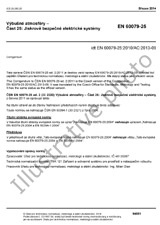We need your consent to use the individual data so that you can see information about your interests, among other things. Click "OK" to give your consent.

IEEE C62.92.2-2017
IEEE Guide for the Application of Neutral Grounding in Electrical Utility Systems, Part II--Synchronous Generator Systems
Translate name
STANDARD published on 19.5.2017
The information about the standard:
Designation standards: IEEE C62.92.2-2017
Publication date standards: 19.5.2017
SKU: NS-684345
The number of pages: 38
Approximate weight : 114 g (0.25 lbs)
Country: International technical standard
Category: Technical standards IEEE
Annotation of standard text IEEE C62.92.2-2017 :
Revision Standard - Active.
The basic factors and general considerations in selecting the class and means of neutral grounding for synchronous generator systems connected to electrical utility systems are provided in this guide. It also provides the suggested methods and apparatus to be used to achieve the desired grounding. These guidelines apply to both large and small generators found in electrical utility systems. Definitions of grounding terms used in this the guide can be found in IEEE Std C62.92.1(TM)-2000.
ISBN: 978-1-5044-3723-3, 978-1-5044-3724-0
Number of Pages: 38
Product Code: STD22414, STDPD22414
Keywords: electric utility systems, IEEE C62.92.2™, mechanical stress in generators, neutral grounding, overvoltages on generator insulation, synchronous generators, unit-connected generation systems
Category: Surge-Protective Devices
We recommend:
Updating of laws
Do you want to be sure about the validity of used regulations?
We offer you a solution so that you could use valid and updated legislative regulations.
Would you like to get more information? Look at this page.



 Cookies
Cookies
